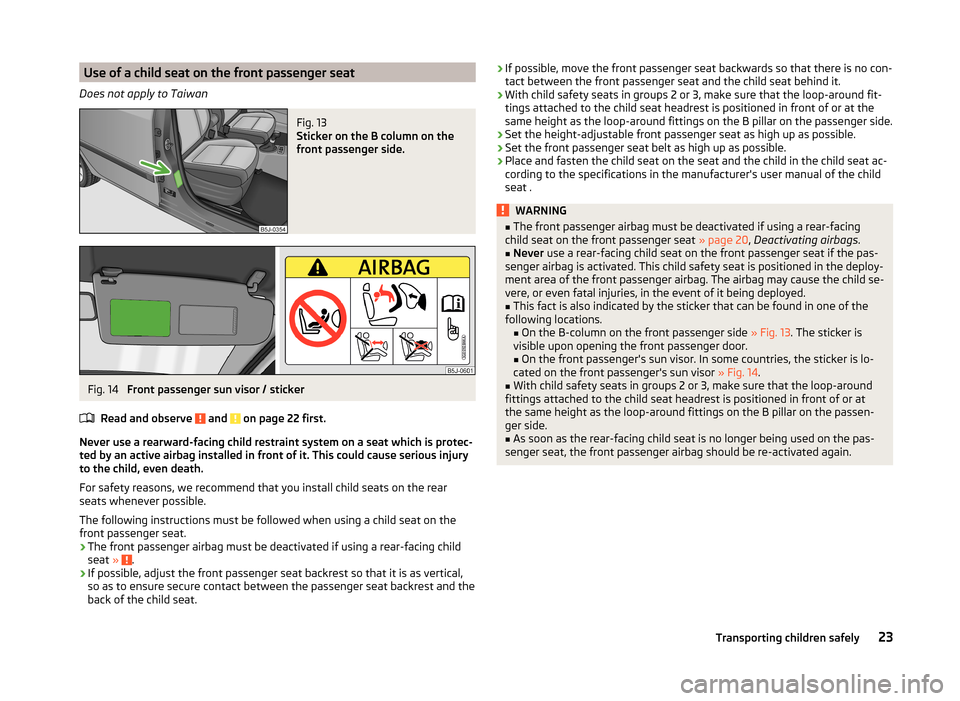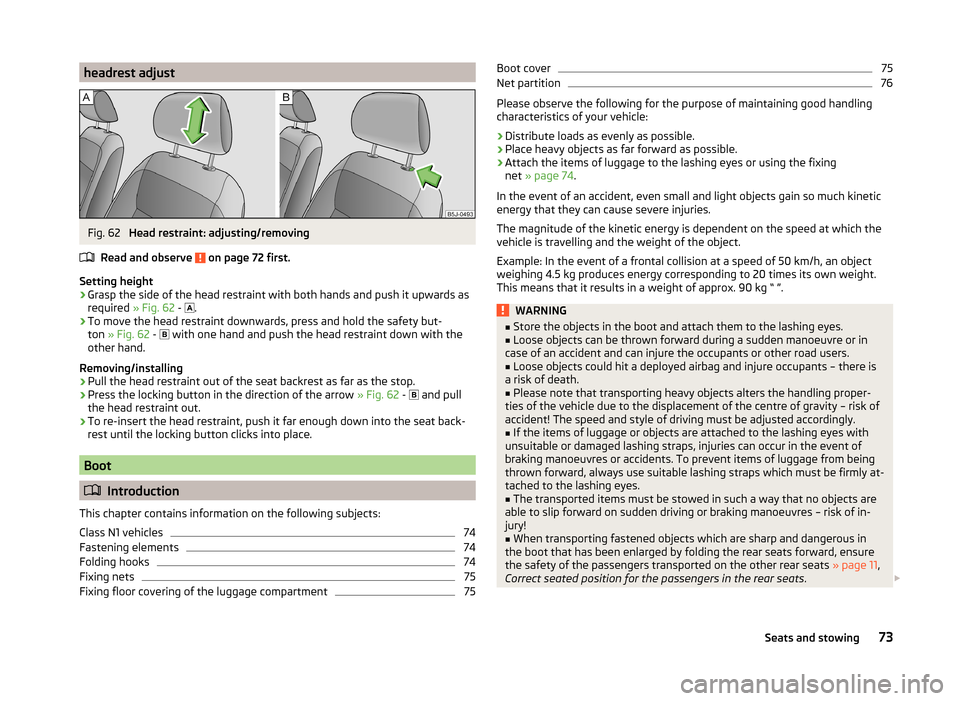2014 SKODA ROOMSTER headrest
[x] Cancel search: headrestPage 26 of 204

Use of a child seat on the front passenger seat
Does not apply to TaiwanFig. 13
Sticker on the B column on the
front passenger side.
Fig. 14
Front passenger sun visor / sticker
Read and observe
and on page 22 first.
Never use a rearward-facing child restraint system on a seat which is protec-
ted by an active airbag installed in front of it. This could cause serious injury
to the child, even death.
For safety reasons, we recommend that you install child seats on the rear
seats whenever possible.
The following instructions must be followed when using a child seat on the
front passenger seat.
› The front passenger airbag must be deactivated if using a rear-facing child
seat »
.
› If possible, adjust the front passenger seat backrest so that it is as vertical,
so as to ensure secure contact between the passenger seat backrest and the
back of the child seat.
› If possible, move the front passenger seat backwards so that there is no con-
tact between the front passenger seat and the child seat behind it.
› With child safety seats in groups 2 or 3, make sure that the loop-around fit-
tings attached to the child seat headrest is positioned in front of or at the
same height as the loop-around fittings on the B pillar on the passenger side.
› Set the height-adjustable front passenger seat as high up as possible.
› Set the front passenger seat belt as high up as possible.
› Place and fasten the child seat on the seat and the child in the child seat ac-
cording to the specifications in the manufacturer's user manual of the child
seat .WARNING■ The front passenger airbag must be deactivated if using a rear-facing
child seat on the front passenger seat » page 20, Deactivating airbags .■
Never use a rear-facing child seat on the front passenger seat if the pas-
senger airbag is activated. This child safety seat is positioned in the deploy-
ment area of the front passenger airbag. The airbag may cause the child se-
vere, or even fatal injuries, in the event of it being deployed.
■
This fact is also indicated by the sticker that can be found in one of the
following locations. ■ On the B-column on the front passenger side » Fig. 13. The sticker is
visible upon opening the front passenger door.
■ On the front passenger's sun visor. In some countries, the sticker is lo-
cated on the front passenger's sun visor » Fig. 14.
■
With child safety seats in groups 2 or 3, make sure that the loop-around
fittings attached to the child seat headrest is positioned in front of or at
the same height as the loop-around fittings on the B pillar on the passen-
ger side.
■
As soon as the rear-facing child seat is no longer being used on the pas-
senger seat, the front passenger airbag should be re-activated again.
23Transporting children safely
Page 75 of 204

Adjusting seats in crosswise directionFig. 60
Locking seats
›
Remove the middle seat » page 71, Unlocking and removing seats .
›
Fold the outer seat forwards » page 71, Fold downseat backrest and seat
fold down completely and unlock » Fig. 59 on page 71 .
›
Move the folded forward and unlocked seat on the guide towards the middle
of the vehicle up to the stop.
›
Lock the folded seat by pressing seat locks
A
» Fig. 60 in the direction of
the arrow.
Folding the rear seats into the starting position
Fig. 61
Folding the seat backrest back
into position
›
If the seat has been removed, first position it on the guide and lock it in
place » Fig. 60 on page 72 . Pull the seat upwards to ensure that the seat is
locked correctly.
›
Fold the seat in the horizontal position until it can be heard to click. Check for
yourself that the seat can no longer be lifted by pulling it up.
›
Press the lever » Fig. 61 and fold back the seat backrest. Check for yourself
that the seat backrest is engaged by pulling on it.
›
Remove the tongue of the lock from the safety position.
WARNING■ The belt locks must be in their original position after folding back the seat
cushions and backrests - they must be ready to use.■
The seat backrests must be securely latched in position so that no ob-
jects from the luggage compartment can slip into the passenger compart-
ment under sudden braking – there is a risk of injury.
■
When folding the seat backrest always make sure that it has safely
locked into position, this is confirmed by the position and a visible marking
on the cover of the lever.
Head restraints
Introduction
This chapter contains information on the following subjects:
headrest adjust
73
Best protection is achieved if the top edge of the head restraint is at the same
level as the upper part of your head.
The head restraints must be adjusted to match the size of the seat occupant.
Correctly adjusted head restraints together with the seat belts offer effective
protection for the occupants » page 9.
WARNING■
The head restraints must be correctly adjusted in order to offer effective
protection for the occupants in the event of an accident.■
Never drive with the head restraints removed - risk of injury.
■
If the rear seats are occupied, the rear head restraint must not be in the
lower position.
72Operation
Page 76 of 204

headrest adjustFig. 62
Head restraint: adjusting/removing
Read and observe
on page 72 first.
Setting height
›
Grasp the side of the head restraint with both hands and push it upwards as
required » Fig. 62 -
.
›
To move the head restraint downwards, press and hold the safety but-
ton » Fig. 62 -
with one hand and push the head restraint down with the
other hand.
Removing/installing
›
Pull the head restraint out of the seat backrest as far as the stop.
›
Press the locking button in the direction of the arrow » Fig. 62 -
and pull
the head restraint out.
›
To re-insert the head restraint, push it far enough down into the seat back-
rest until the locking button clicks into place.
Boot
Introduction
This chapter contains information on the following subjects:
Class N1 vehicles
74
Fastening elements
74
Folding hooks
74
Fixing nets
75
Fixing floor covering of the luggage compartment
75Boot cover75Net partition76
Please observe the following for the purpose of maintaining good handling
characteristics of your vehicle:
›
Distribute loads as evenly as possible.
›
Place heavy objects as far forward as possible.
›
Attach the items of luggage to the lashing eyes or using the fixing
net » page 74 .
In the event of an accident, even small and light objects gain so much kinetic
energy that they can cause severe injuries.
The magnitude of the kinetic energy is dependent on the speed at which the
vehicle is travelling and the weight of the object.
Example: In the event of a frontal collision at a speed of 50 km/h, an object
weighing 4.5 kg produces energy corresponding to 20 times its own weight.
This means that it results in a weight of approx. 90 kg “ ”.
WARNING■ Store the objects in the boot and attach them to the lashing eyes.■Loose objects can be thrown forward during a sudden manoeuvre or in
case of an accident and can injure the occupants or other road users.■
Loose objects could hit a deployed airbag and injure occupants – there is
a risk of death.
■
Please note that transporting heavy objects alters the handling proper-
ties of the vehicle due to the displacement of the centre of gravity – risk of
accident! The speed and style of driving must be adjusted accordingly.
■
If the items of luggage or objects are attached to the lashing eyes with
unsuitable or damaged lashing straps, injuries can occur in the event of
braking manoeuvres or accidents. To prevent items of luggage from being
thrown forward, always use suitable lashing straps which must be firmly at-
tached to the lashing eyes.
■
The transported items must be stowed in such a way that no objects are
able to slip forward on sudden driving or braking manoeuvres – risk of in-
jury!
■
When transporting fastened objects which are sharp and dangerous in
the boot that has been enlarged by folding the rear seats forward, ensure
the safety of the passengers transported on the other rear seats » page 11,
Correct seated position for the passengers in the rear seats .
73Seats and stowing
Page 196 of 204

Glow plug systemWarning light43
GSM97
H
Handbrake
109
Hazard warning light system63
Head airbag19
Headlight cleaning system Headlight cleaning system
67
Headlights179
Driving abroad118
Headlight cleaning system67
Headrest Headrest
73
Head restraint72
Heating Deicing the windows
92
Exterior mirrors68
Operating91
Operation91
Rear window64
Recirculated air mode92
Seats69
Heating and air-conditioning90
Hill hold control119
Hitch126
Accessories129
Drawback load126
Horn29
I
Ignition
107
Ignition lock107
Immobilizer107
Individual settings locking
50
unlocking50
Inertia reels15
Instrument cluster30
Overview30
see instrument cluster30
Interior monitor54
Internal lighting Praktik
89
Internal lights Praktik
89
ISOFIX25
J
Jack
166
Maintenance138
Jump-starting172
L
lashings Praktik
88
Light Cockpit
63
Dimmed headlights59
Headlight beam adjustment60
Headlight flash61
Sidelights59
Lights59
Cockpit63, 64
Daylight running60
Fog lights61
Foglights with the CORNER function62
Halogen projector headlights with cornering light function
61
Hazard warning light system63
Main beam lights61
Parking lights63
Rear fog light62
Replacing bulbs178
Tourist lights62
Turn signals61
warning lights39
Lock Central locking system51
Locking Emergency locking
49
Remote control52
without central locking49
Locking and unlocking from the inside51
Low tyre pressure warning refer to the tyre pressure monitoring
125
Luggage compartment Class N1 vehicles
74
Lighting64
Variable loading floor76
Luggage compartment lid54
M
Main beam
61
Maintenance116
Decorative films137
Manual air conditioning Recirculated air mode
94
Manual gear changing see gear changing
109
MAXI DOT Main menu
37
see MAXI DOT display37
Settings38
MAXI DOT display37
Maximum permissible weights
183
Maximum speed186
MDI104
Mechanical windows58
open and close58
Media see radio / navigation system
4
193Index